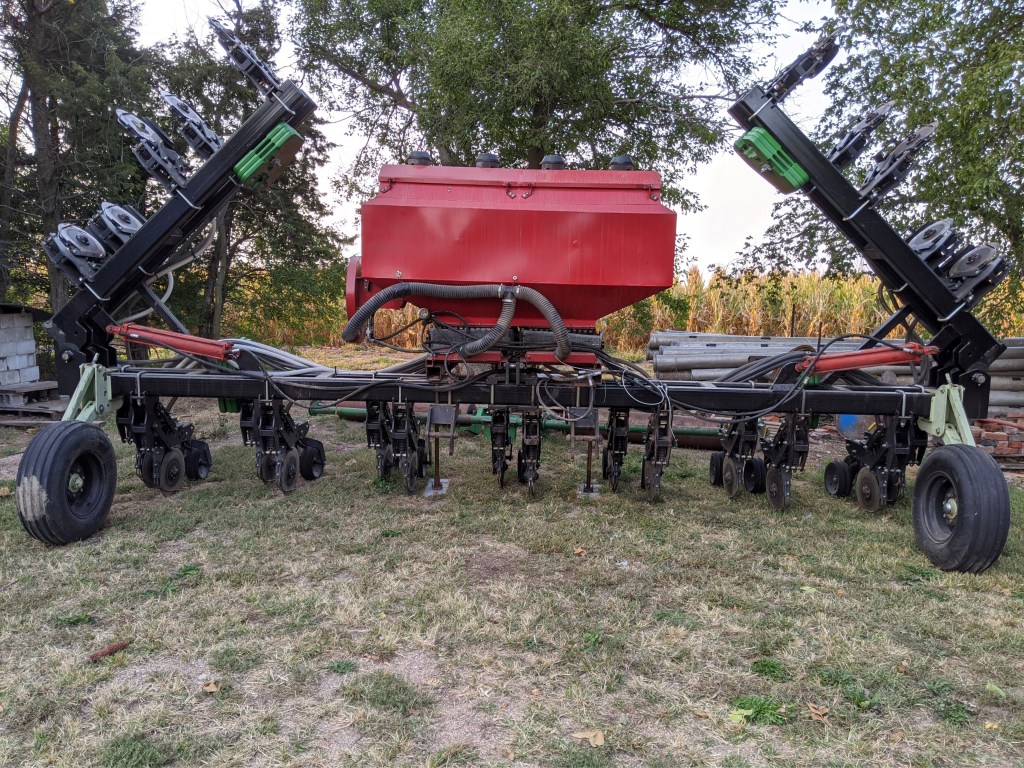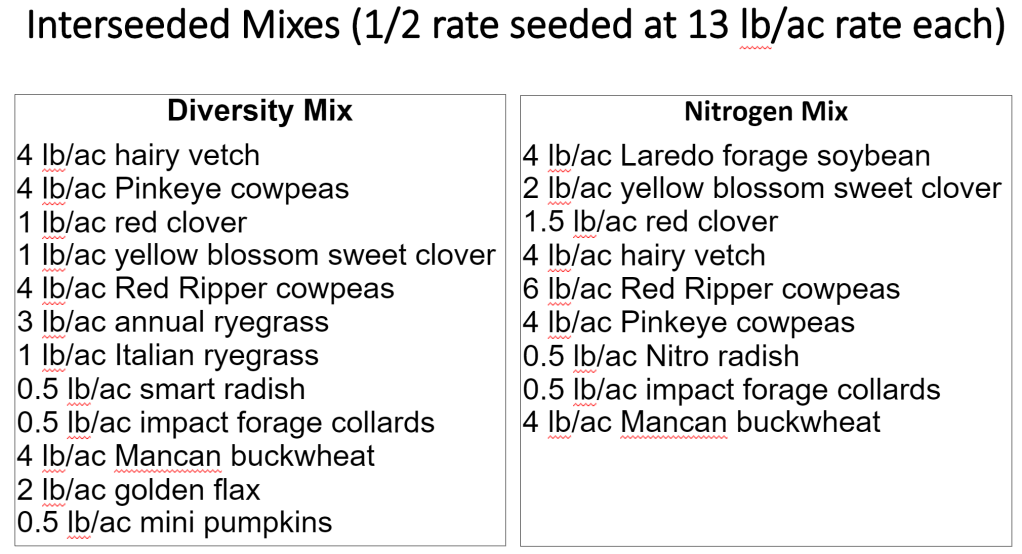Blog Archives
JenREES 5/9/21
Hopefully the rains were a blessing in helping the crops where crusting was a concern, adding moisture to the seedbed, and in activating herbicide. This article reaches people throughout the State, so with some experiencing frost potential as I write this, if rhubarb leaves are not damaged too much by frost and the stalks remain firm, it is still safe to eat. If the leaves are severely damaged or the stalks become soft or mushy, do not eat these stalks. Remove and discard them. New stalks can be harvested and eaten. Rhubarb often develops seedheads following cold temperatures, but this also does not affect eating quality of the stalks. Remove rhubarb seedheads and discard.
This week will share on the results we obtained from on-farm research studies where cover crops were interseeded into corn. In 2019, there were two locations in York and Seward counties (interseeded at V5-V6). In 2020, 6 of 11 locations were conducted via on-farm research in York, Seward, Clay, and Hamilton counties (interseeded at V4). Four of the six locations compared an interseeded cover crop to a check treatment of no cover crop. One location compared two corn populations (27,000 vs. 31,000 seeds/ac) to determine corn yield and cover crop biomass impacts. One location compared using only the middle drill unit to interseed the cover crop vs. using all three drill units between the rows to determine any differences in cover crop biomass.
2019 Results: In 2019, the cover crop at the Seward county location emerged and then died, we hypothesize, due to reactivation of Group 27 herbicide. Thus, no biomass samples were taken. At the York county location, cover crop biomass sampled prior to the first hard freeze ranged from 97-220 lbs/ac. It was good to see successful establishment at both locations and that cover crop growth occurred at one of them. In 2019, there were no yield differences between the corn in the check treatments (241 and 258 bu/ac) vs. cover crop interseeded treatments (241 (N mix), 243 (diversity mix), and 256 bu/ac) at the York and Seward locations respectively, which was also encouraging. Net return was less for the interseeded cover crop treatments vs. the check.
2020 Results: In 2020, cover crops emerged at all locations and grew throughout the season. Cover crop biomass varied by location with the most occurring in fields that were damaged by the July 9, 2020 windstorm (the location with the greatest biomass had 45% green snap). Thus, the open canopy resulted in greater weed and cover crop biomass. Biomass samples were collected in late September by taking three 30” X 30” or 36 X 36” squares for each treatment (dependent upon row spacing). The samples were sorted in the field into weeds, interseeded forbs/legumes, and interseeded grasses and placed in separate paper bags. Samples were weighed and dried. We wanted to compare any differences in weed biomass between the check and interseeded treatments, especially since no residual herbicides were used in 2020. There were no differences in weed biomass between the check and interseeded cover crop treatments. Total cover crop biomass accumulated varied by site and ranged from 277 lb/ac to 3818 lb/ac. It should be noted that the cover crops continued to grow after we sampled until the first hard freeze occurred. The cowpeas provided the greatest biomass and grew to the tops of the tassels. They also formed a ‘bridge’ between corn rows where the canopy broke open. Cowpeas, hairy vetch, sweetclover, and forage soybean were all fixing nitrogen during the 2020 growing season. The red clover and hairy vetch that survived the winter were fixing nitrogen in the spring of 2021.
The windstorm greatly impacted yields as well. Across all the sites, corn yield for the check averaged 214 bu/ac while corn yield for the interseeded treatment yielded 209 bu/ac. At four of the six sites, yield was significantly lower where the cover crop was interseeded. At the remaining two sites yield was not different between treatments. Net return for the corn where the cover crop was interseeded was less at five of the six locations. Net return includes the yield and price of the corn crop and cost of cover crop seed and application. Other than the York county location (two years), all the location data is based on one year of research. These studies will continue in the same fields and strips for at least three years, so it will be interesting to watch for any changes in soil biological and physical properties over time as well. Visually, in the field where the center drill unit vs. 3 was used, it appeared that the 1 drill unit had more biomass. Statistically, it ended up the same as the three drill units for total cover crop biomass. At the York location where cover crops were interseeded into two corn populations, there were no yield differences between the corn populations; however, both yielded less than the check treatment. A special thanks to all the growers working with us on these interseeding cover crop studies and to The Nature Conservancy, Upper Big Blue NRD, NRCS, and Kellogg’s for their partnership with Nebraska Extension on this effort. If you’d like more information, I’ve provided tables of data and links to videos we produced at my blog site jenreesources.com.

0.5 lb/ac chicory) interseeded at V5-V6 corn vs. check treatment.
Seward County (right), a Hagie was used to broadcast interseed 10 lb/ac red clover and 5 lb/ac buckwheat into V6 corn vs. check treatment.

* denotes statistically significant at 90% confidence level.

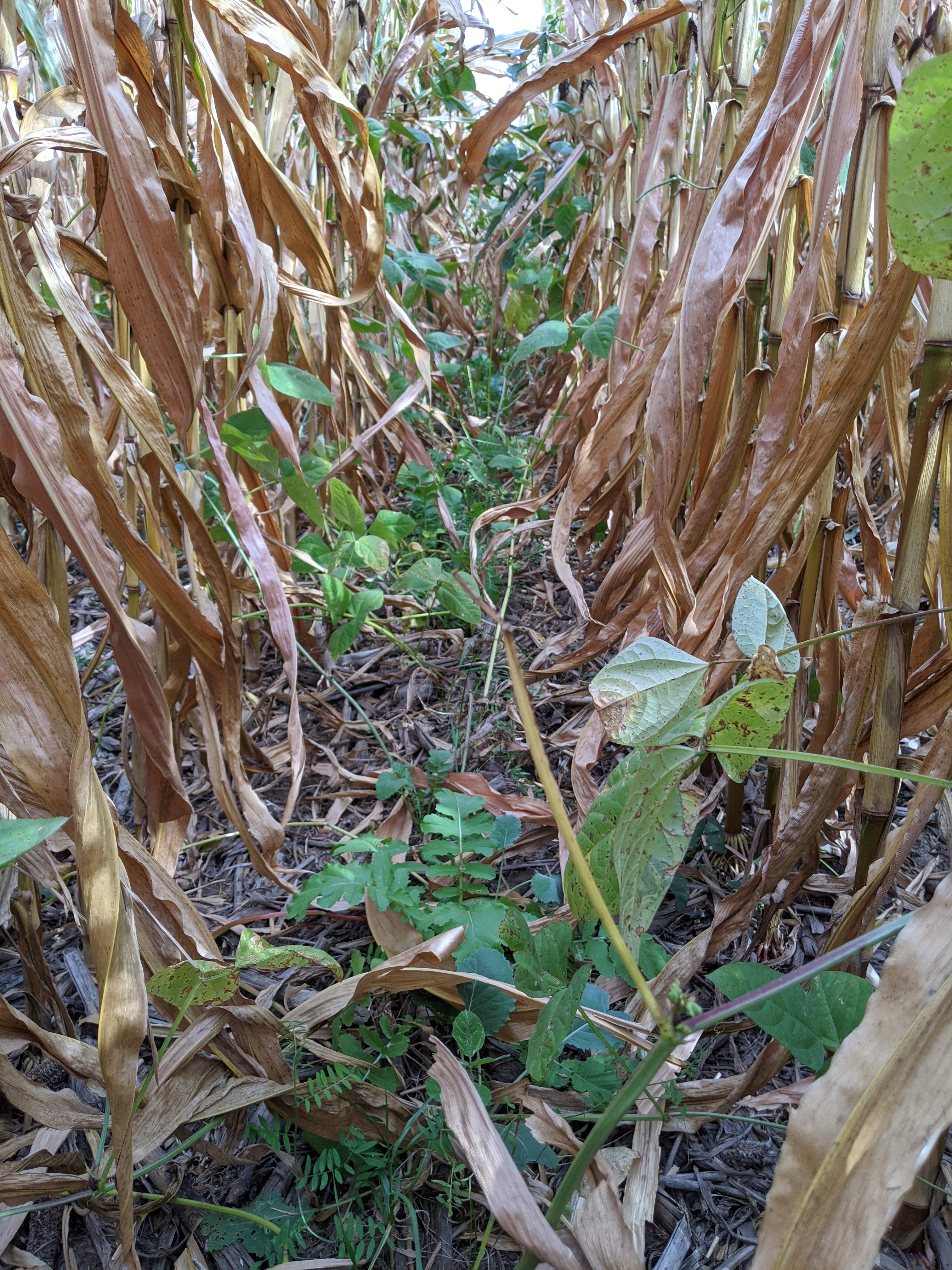

Cover crop biomass as a result of interseeding using three drill units (left) vs. only the center drill unit (middle). Close up of Penn State Interseeder drill units (right).
Nebraska On-Farm Research Virtual Field Day Interseeding Videos:
- Interseeding drills: https://cropwatch.unl.edu/interseeding-cover-crops-steve-melvin-june-12-2020
- Interseeding into Soybean: https://cropwatch.unl.edu/interseeding-cover-crops-soybeans-steve-melvin-june-10-2020
- Interseeding studies: https://youtu.be/gQKAGzkweG4
- Interseeding Mixes: https://youtu.be/b64PCMV1pwc
- Interseeding and Herbicide programs: https://youtu.be/5P8tE3oQ7hA
JenREES 5/2/21
With the challenge of growing cover crops, particularly after corn harvest, interest in interseeding cover crops into living corn and soybean has increased in recent years. Goals for doing so include using the cover to: grow nitrogen for the crop, remove excess nitrogen (in the case of seed corn), aid in weed and erosion control, increase biodiversity, determine any soil health benefits, and desire for fall biomass for grazing. Some are also concerned about increasing regulation and wanting to figure things out ahead of the curve. Planning is key when it comes to interseeding cover crop into corn or soybean. Planning needs to include the goal of why interseed, the cover crop species interseeded, how the cover will be interseeded, the corn/soybean crop development stage for interseeding, and the herbicide program used.
A few years ago, we wrote an article sharing what was known about interseeding cover crops. The following is information we’ve learned as an interseeding project between The Nature Conservancy, Upper Big Blue NRD, Nebraska Extension, 11 farmers, NRCS, and Kellogg’s.
Timing: In corn, we’d recommend aiming for V4 (four leaf collars). V5-V6 is almost too late in years where canopy closure occurs quickly. The literature says there’s no yield loss after V2. For soybean, aerial interseeding around senescence (leaves turning yellow) is one option. From plots interseeded at V4 in 2020, we felt that was almost too late for aiding establishment. This year we will be trying at planting through V2.
Species: Penn State has a mix that’s considered the interseeding standard; it includes annual ryegrass, red clover, and hairy vetch. From the 12 species mixes we tried, the annual ryegrass, vetch, red clover all survived and were growing this spring. Thus, most likely why it’s considered the standard.
In corn, we’ve tried multispecies mixes because of the growers’ and partners’ goals and testing what came through different herbicide programs. We found the first species to emerge were the buckwheat and cowpeas. The farmers liked the species that provided more of an understory like the annual and Italian ryegrass, collards and other brassicas, and buckwheat. Cowpeas grew up to the corn tassels and provided the greatest biomass. Most of the species went to seed. Cowpeas, forage soybeans, and sweet clover were fixing nitrogen in season.
For diversity, the flax and buckwheat upon flowering drew many beneficial insects to the field. Pests like grasshoppers ate the covers in the interseeded strips and left the corn alone from what I observed.
In soybean, wheat was planted in the soybean management field day trials last year with some success. This year we’re considering wheat + red clover for the fields that will be interseeded from planting through V2.
Herbicide Programs: This is the difficult part. I think ideally (and I’m unsure if this is even realistic yet), a cover between rows aiding in weed control, adding nitrogen, providing fall biomass, and regrowing the following spring to aid in weed control again with only needing to add herbicide in a band, would be pretty cool.
In the wet year of 2019, Callisto-type (Group 27) products did their job and kept re-activating. This led to covers dying in one field. So in 2020, I suggested no residuals in post- apps. The guys went with me on this with most doing a pre- with residual followed by a post- of only glyphosate or Liberty prior to interseeding. The July 9th, 2020 windstorm causing plants to greensnap and/or bend caused problems with the canopy opening up and weed control in addition to biomass growth became a problem in these fields in competing with the corn crop. I was just sick about this and the guys extended much grace to me.
This year, for corn, some guys are sticking with last year’s program because it worked well for them, particularly in no-till with heavy residue. Another thing some may try is to apply a pre- with residual, interseed at V4 and then upon 1-2” growth of the covers, apply Dual II Magnum or Outlook (no grazing restriction with Outlook) to provide residual to aid in weed suppression. One farmer who applied generic Lexar pre-plant in some fields and did split app in others in 2020, still saw cover crop growth and emergence from the split applied. The cover crop growth in the split-applied was just stunted and thin compared to the fields where he applied the full rate pre-. He’s testing herbicide programs this year.
For soybean, there’s even more risk. For those who wish to plant and interseed at the same time, we’re trying a burndown immediately prior to interseeding (if they hadn’t applied an early pre- already), allowing the cover to get 1-2” tall and then go with a Group 15 chemistry. The other option we’re trying is going with their pre- with residual followed by interseeding at V2 and application of Group 15 herbicide after cover reaches 1-2” of growth. We also have guys who are planting soybean green into rye and will try interseeding after rye termination. We have no idea how all this will work and if others have ideas, please feel free to share! Next week I’ll share the yield and biomass results from the past few years.
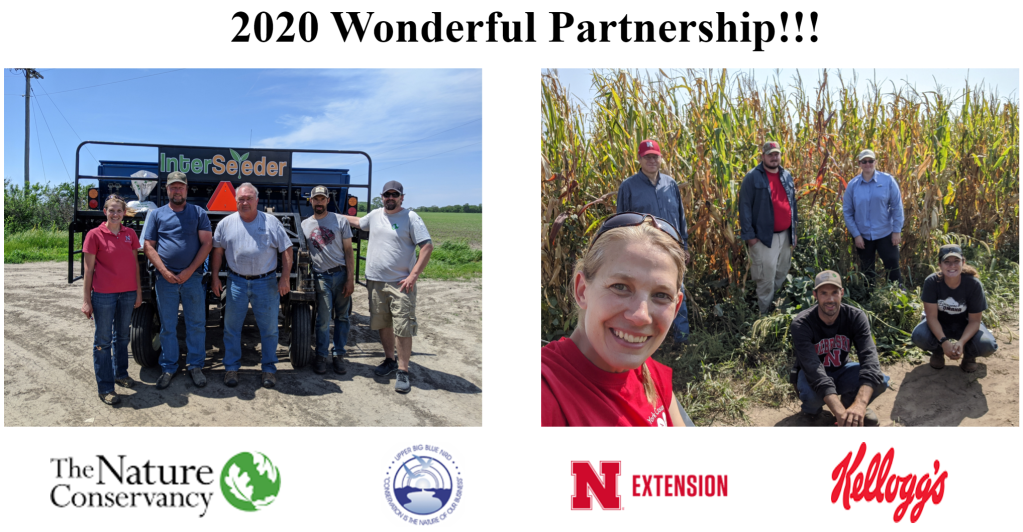


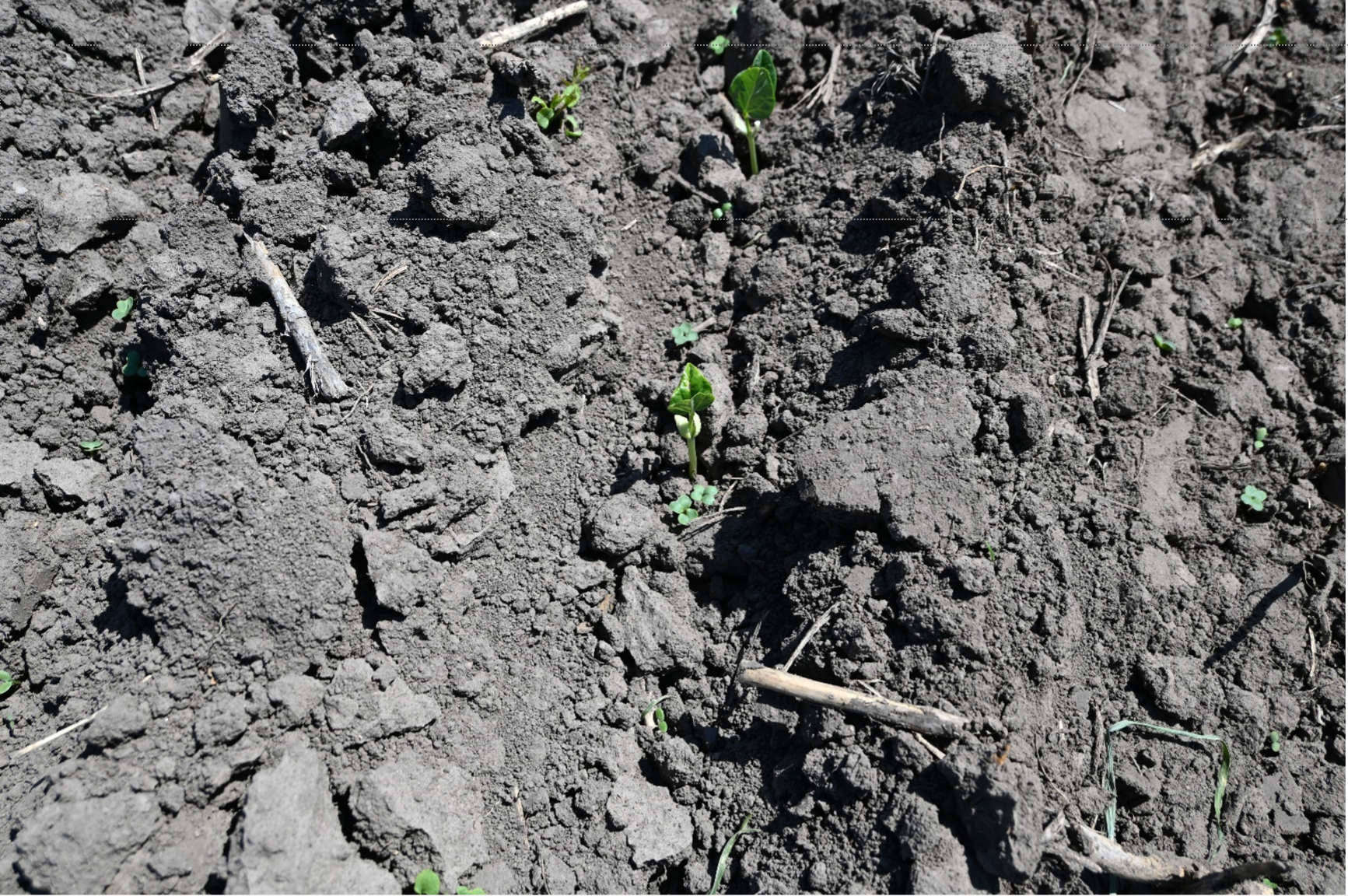
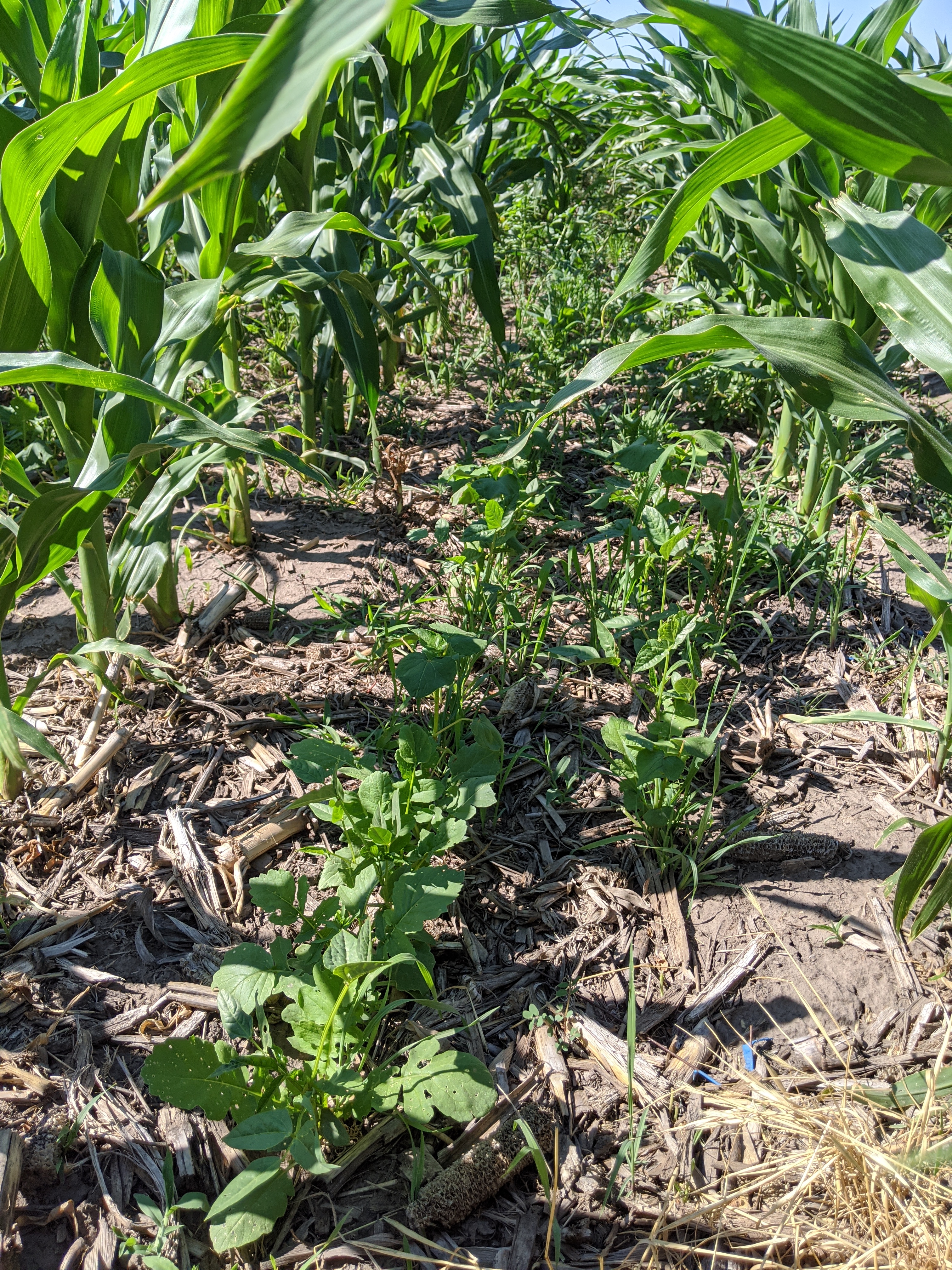
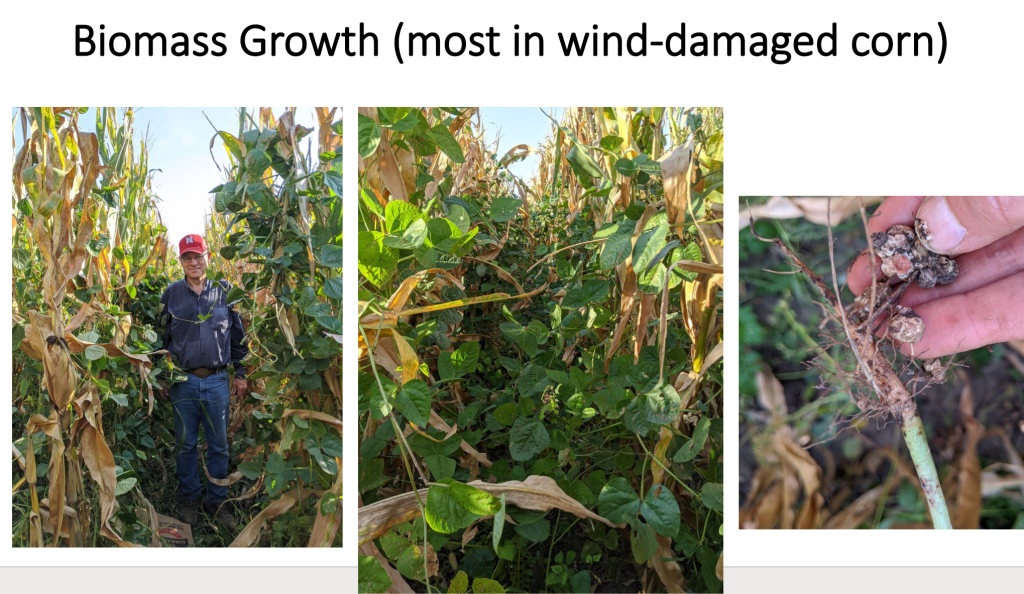
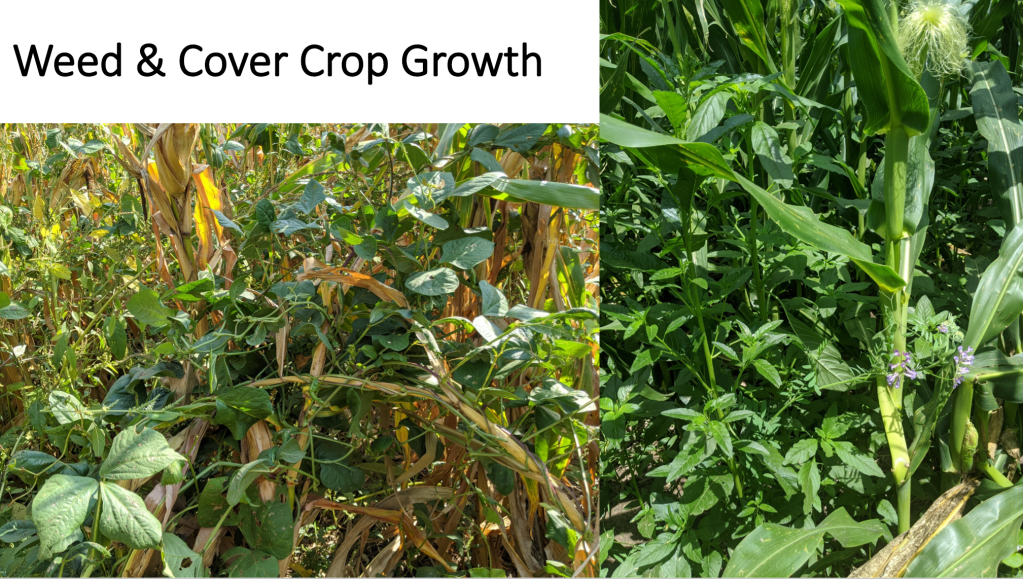
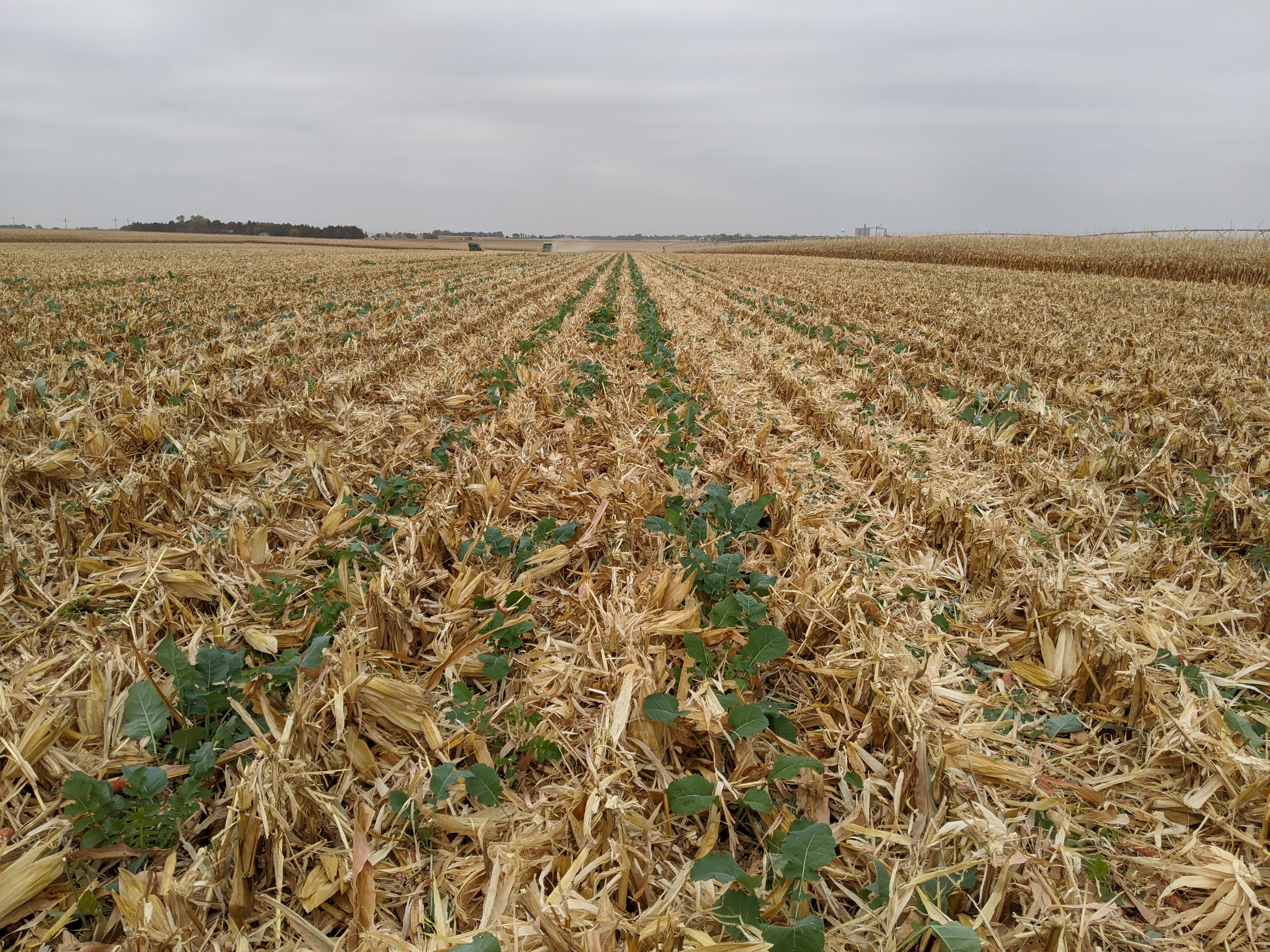

The above pics were post-harvest. The covers showed good at that time still but they seemed to disappear pretty fast upon more hard frosts.

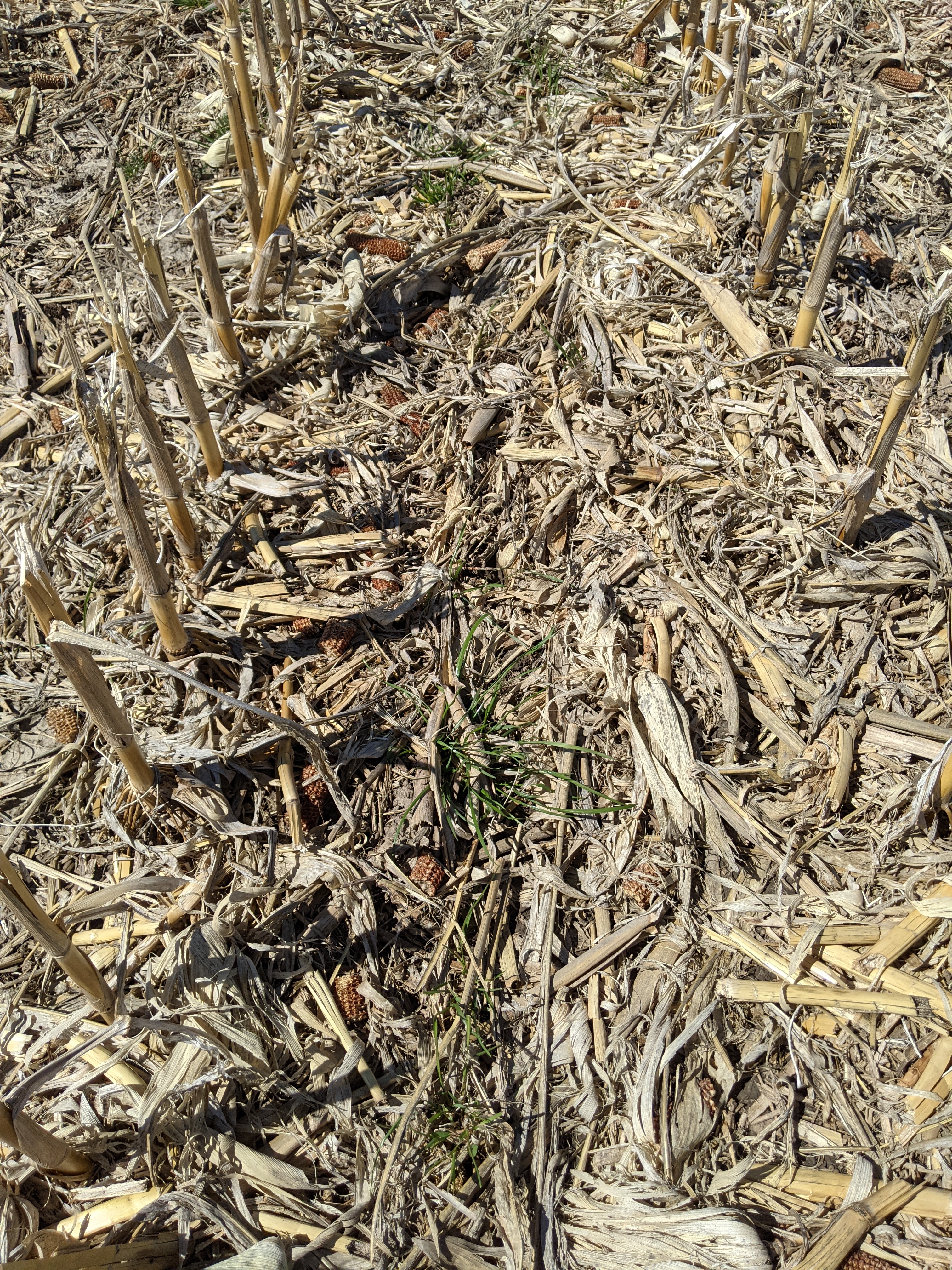

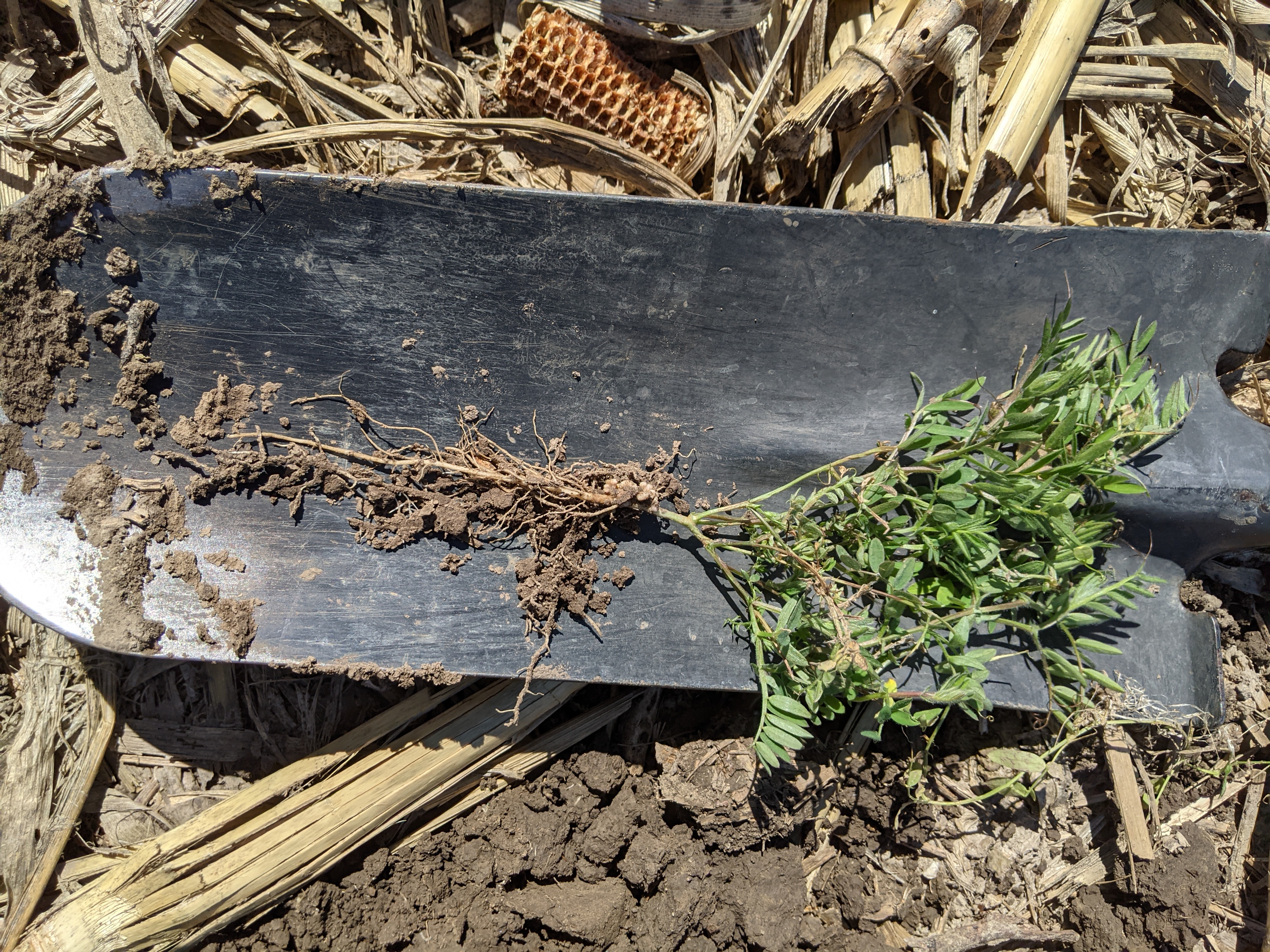

The above pictures were taken in March 2021 of spring growth. Annual ryegrass, hairy vetch, red clover, and collards survived the winter. As time went on, one could easily ‘row’ where the covers were interseeded in June 2020. The taproots on the red clover were extra impressive to me! Also, pretty much always saw earthworms when I dug up one of these plants.
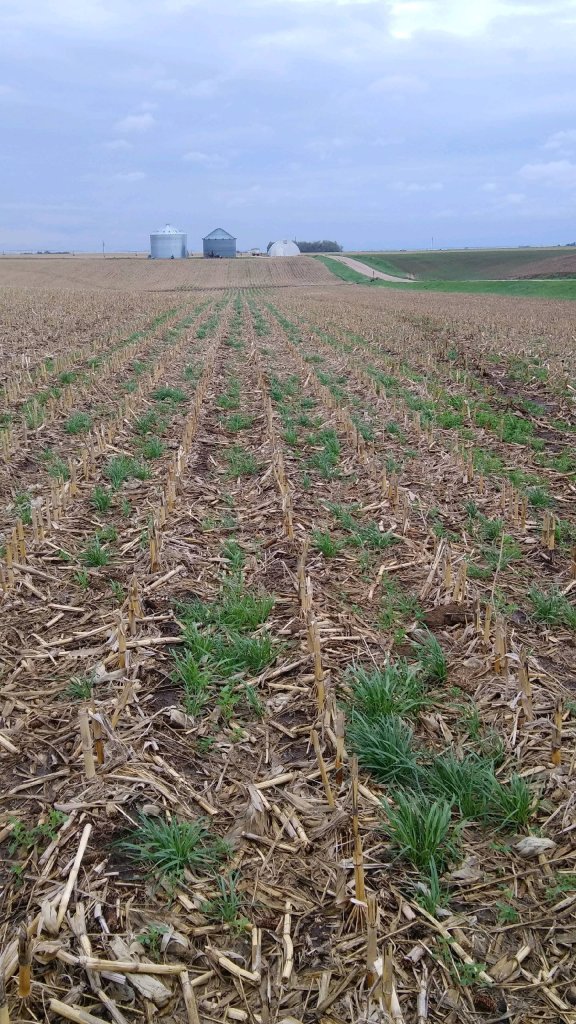

JenREES 4-1-18
Hope you had a blessed Easter! The Wheat Stem Maggot in Cover Crop Webinar can now be viewed at: https://www.youtube.com/watch?v=XGjuzMlrjhQ&feature=youtu.be. The link for the survey mentioned in the webinar is no longer available but you are welcome to contact Dr. Justin McMechan for additional comments/questions. He goes through a number of insects to watch for and his ultimate message is to scout to determine termination timing.
Cover Crop Interseeding: A few weeks ago I attended the interseeding cover crops field day which had a really good attendance for March! For those of you considering this, I learned it’s best to start earlier than V6…consider V3 and if it’s wet, you have a better chance of actually getting interseeding accomplished by V6. This is year 3 of their study. The first year they used a spreader to seed the mixes. The second year they found utilizing insecticide boxes for the seeding when they cultivated worked the best. The third year they used a Hiniker inter-row seeder which they purchased.
Regarding mixes, most of them included annual ryegrass or cereal rye. There’s a Penn State mix (27# total of annual ryegrass, red clover, and hairy vetch) that has been successful in northern U.S. states. Very little cover was observable this spring, but from a photo provided, it appeared growth came on during corn senescence and after harvest last year. Fall biomass wasn’t measured last year which will hopefully be measured in the future to obtain more data on the success of the mixes. My take, if your goal is early spring grazing or early spring cover, I’m unsure that much can beat cereal rye, even if it was dormant seeded. If you’re looking for a way to get some cover established prior to corn harvest for either fall grazing or just fall soil cover, interseeding with a mix containing the annual ryegrass looked good from the pictures they showed. If you’re interested in any cover crop or other on-farm research studies this year, please let me know!
but from a photo provided, it appeared growth came on during corn senescence and after harvest last year. Fall biomass wasn’t measured last year which will hopefully be measured in the future to obtain more data on the success of the mixes. My take, if your goal is early spring grazing or early spring cover, I’m unsure that much can beat cereal rye, even if it was dormant seeded. If you’re looking for a way to get some cover established prior to corn harvest for either fall grazing or just fall soil cover, interseeding with a mix containing the annual ryegrass looked good from the pictures they showed. If you’re interested in any cover crop or other on-farm research studies this year, please let me know!
Tree Care Workshop: Trees are very valuable in our landscapes. They provide us with beauty, shade, oxygen, and better resale on our homes. These trees need our help to ensure they have healthy growth. When they have a disease or insect problem, it is up to us to manage those pests to help them live many years. On Wednesday, April 18th from 5:30-7 p.m. at the Fairgrounds in Clay Center, Nicole Stoner will teach us what to do with our trees. Nicole is a Horticulture Educator from Gage County. This tree program is $5.00 and will cover light refreshments and your educational materials. Nicole will cover watering, insect and disease problems, general care, and planting of trees. Please pre-register by April 13th with Nebraska Extension in Clay County by calling 402-762-3644 or emailing dpeshek2@unl.edu.
Spring Affair Plant Sale: Spring Affair, the Midwest’s largest plant sale and gardening event, will be Saturday, April 28 at the Lancaster Event Center in Lincoln from 9 a.m. to 2 p.m. More than 700 different varieties of perennials, herbs, grasses, trees, shrubs and other plants will be available. They are selected for regional suitability, uniqueness, popular demand and provided by Bluebird Nursery, Inc., of Clarkson, Neb. It is sponsored by the Nebraska Statewide Arboretum as an educational tool, fundraising event and to promote regional plants. For information and inspiration, half hour plant talks will be offered at:
- 10:00 – “Nebraska Native Plants for Birds” by Jason St. Sauver, Spring Creek Prairie Audubon Center
- 11:00 – “Gardening 101: I’ve got my plants, now what?” by Justin Evertson, Green Infrastructure Coordinator for the Nebraska Statewide Arboretum
- 12:00 – “The Guilt-free Garden” by Mark Canney, Park Planner & Designer for Lincoln Parks & Recreation
Admission to the sale is free. The plant sale, presentations, educational booths and vendors of garden-related items are all in Pavilion I of the Lancaster Event Center with plenty of free parking. For more information, visit https://plantnebraska.org/spring-affair.
DriftWatch/BeeCheck: Nebraska Department of Ag (NDA) encourages pesticide applicators to check out DriftWatch/BeeCheck at http://driftwatch.org to minimize pesticide drift. It’s important for those with sensitive sites such as organic, bees, vegetables, grapes, etc. to add them to this website and important for all applicators to check this website for sensitive locations around our fields. Several states have been added to DriftWatch/BeeCheck in the last year and a few more are in the works, making it more beneficial to applicators working near the state line or those working in multiple states. FieldWatch, the company that manages DriftWatch/BeeCheck, now offers data subscriptions for obtaining data files for GIS maps or live stream data through several mapping software providers. It will be rolling out a new mobile app very soon, FieldCheck, for applicators who have registered as an applicator (which is free to do). You can also view the most recent edition of NDA’s Plant Health Protection Update at: https://us14.campaign-archive.com/home/?u=eb13611bfcca17410ce5c5f52&id=10756f8d33.

